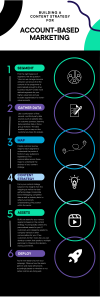Recently, I had the privilege of speaking at a half-day workshop organised by LinkedIn, where we discussed tackling the significant challenges associated with account-based marketing (ABM), particularly content creation and measurement. It was an enriching experience to hear from various speakers who shared their insights and real-world experiences in implementing successful ABM programmes. This event gave me three valuable reflections of the common pitfalls that companies often encounter when developing content for an ABM programme and prompted me to think ahead of what can be done.
#1 Striking the balance between personalisation and resource use
Account-based marketing is a strategic approach that emphasises targeting specific high-value accounts and treating them as unique markets. However, it’s crucial to resist the temptation of attempting to target all accounts at an (almost) individual level. While personalised content is important, scaling individualisation can be resource-intensive and detrimental to other marketing initiatives, disrupting the overall balance. Therefore, achieving the right equilibrium of accounts by thoughtfully curating the breadth and depth of each segment becomes essential for the success of any ABM programme. By striking this balance, organisations can optimise the use of resources and ensure the smooth functioning of their ABM engine.
#2 Creating content unique to your accounts
Developing content for ABM poses a challenge in understanding the decision-making process and unique needs of each account or account segment. To overcome this challenge, it is crucial to establish strong alignment between the sales and marketing teams. This ensures a shared understanding of goals, strategies, and tactics, as well as deep insights into the customer’s mindset. For instance, while collaborating with Sitecore’s account servicing team, we gained valuable insights into the thought processes of their 1:1 tier accounts. This enabled us to craft tailored narratives that resonated with each company’s aspirations and goals in the short, medium, and long term. By leveraging such insights, organisations can create compelling content that engages and connects with their target accounts on a personal and meaningful level.
#3 Measuring the impact of your content
A third and final reflection is that measurement can be challenging in ABM programmes. The account-centric nature of ABM leads to variations in the frequency and volume of content across different accounts and segments. These variations make it trickier to attribute the impact of a specific asset to eventual conversions, particularly when the same asset is utilised across multiple segments, each with varying sales or industry business cycles. Therefore, a multi-factor measurement model is required to assess the content’s impact on the bottom line, that measures either or both influenced and directly attributed revenue. By employing such a model, organisations can gain a holistic understanding of content’s contribution to ABM’s overall success and accurately evaluate its effectiveness in driving tangible results.
Setting yourself up for success
Taking a structured approach to ABM content development can significantly enhance the outcomes of an ABM programme, in light of the above-mentioned challenges. At Archetype, we have developed a comprehensive six-step framework that guides our clients through the entire process, from segmentation to measurement. This framework ensures that our clients establish a solid foundation for their ABM content strategy, allowing them to effectively target and engage their high-value accounts.


